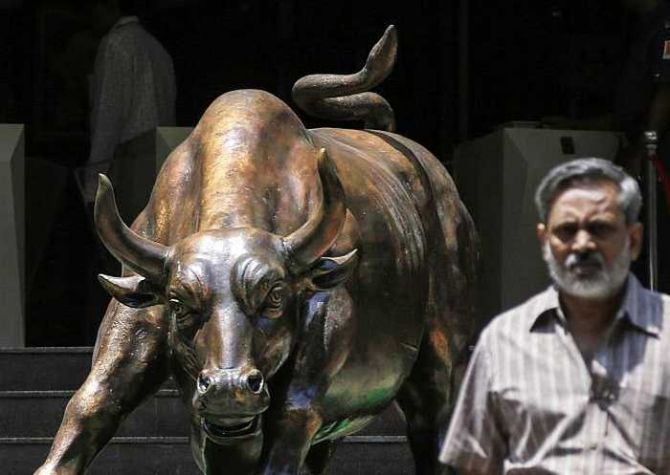 | « Back to article | Print this article |
'The government is encouraging consumption through fiscal spending in a bid to push up economic growth in the face of a slowdown in corporate investment and exports.'

Lending and borrowing money is now India's fastest-growing segment, and the successful industry and lenders are the latest darlings of equity investors.
The share of banks and non-banking finance companies (NBFCs) in the market capitalisation (market cap, or m-cap) of all listed companies is now at an all-time high, as manufacturing companies and non-financial services such as information technology (IT) battle demand slowdown.
Banks and NBFCs, including insurance companies, now account for 22.3 per cent of the combined m-cap -- the highest in at least two decades, and up from 17.2 per cent in March 2014 and 17.3 per cent five-and-a-half years ago in March 2012.
In contrast, the m-cap share of manufacturing companies is now down to a 10-year low of 54 per cent, against 55 per cent at the end of FY14 and around 57 per cent five years ago.
The biggest decline has, however, been recorded by companies in the non-financial services sector, whose largest component is IT exporters such as Tata Consultancy Services, Infosys, and Wipro.
Non-financial services sector companies' share in m-cap has declined to an all-time low of 23.7 per cent, against 28 per cent three years ago.
The combined m-cap of banks and NBFCs is up 145 per cent in the last three years to Rs 30.4 lakh crore now, growing at an annualised rate of 29 per cent since March 2014.
Public sector banks have not participated in this boom as they lend largely to businesses which are now shrinking due to a virtual freeze on fresh investment by the corporate sector.
In the same period, manufacturers' combined m-cap is up 85 per cent to Rs 73.6 lakh crore, growing at an annualised rate of 19.2 per cent during the period.
Non-financial services have been the laggards with the sector, with m-cap up 61 per cent during the period to Rs 32.4 lakh crore now, growing at an annualised rate of 14.6 per cent since March 2014.
The analysis is based on the year-end m-cap and revenues of actively traded companies for every year since 1994-95. This means that the sample gets bigger every year as more companies get listed.
For example, in FY17, the sample had 3,552 companies, while the FY95 numbers were based on a sample of 1,551 companies. However, the absolute numbers are not important, as the analysis is based on a percentage of total m-cap.
It may not show in the overall numbers, but the boom in retail finance has had a knock-on effect on related segments in manufacturing and services.
For example, most of the growth is now occurring in segments such as consumer durables, including passenger cars and two-wheelers, and organised retail, where purchases are loan financed.
Experts attribute this to the growing financialisation of the Indian economy and near stagnation in industrial growth and service exports.
"Private lenders and retail NBFCs continue to grow, even as the rest of the economy is on the verge of stagnation. This has made financial stocks the darlings of investors," says G Chokkalingam, founder and MD, Equinomics Research & Advisory.
It shows in the revenue growth of listed companies across various sectors.
The core revenues (or interest income) of banks and non-bank lenders grew at a compound annual growth rate (CAGR) of 7.3 per cent in the last three years, making the sector one of the fastest-growing in the country.
In the same period, the combined revenues of manufacturers, including utilities and construction firms, grew at a CAGR of 2.8 per cent, while net sales of companies in non-financial services contracted at an annualised rate of 4.8 per cent during the period.
Lenders have also gained from a growing propensity of Indians to borrow for purchasing consumer goods, vehicles or homes.
In the last three years, personal loans or household debt has grown at a CAGR of 18 per cent, against 10.2 per cent compounded growth in disposable income (at current prices) net of taxes during the period, according to the Reserve Bank of India data.
In all, the total household debt is up 65 per cent cumulatively in the last three years, against 35 per cent rise in disposable income during the period.
This has translated into a boom in retail lending and a sharp rise in valuation of retail lenders such as private sector banks and NBFCs, including Housing Development Finance Corporation, Bajaj Finance, Indiabulls Housing, Equitas Holdings, Bharat Financial Inclusion, and PNB Housing.
"Financials are now the only growth industry in the country. This has led to a bubble-like valuation in the retail lending space, especially NBFCs," says Dhananjay Sinha, head of research, Emkay Global Financial Services.
He expects the trend to last for a while, given the growing reliance on private consumption in the economy despite poor growth in jobs and income.
"The government is encouraging consumption through fiscal spending in a bid to push up economic growth in the face of a slowdown in corporate investment and exports.
"Individuals, in turn, are taking on more risks and leveraging their income to keep up consumption despite a slowdown in their income growth in line with the slowdown in gross domestic product growth," says Sinha.
There is, however, a fear that this cycle may break down in the absence of robust growth in industry and exports.
"Consumers' income growth is dependent on the performance of the farm, industrial and service sector, especially software exports. For how long can people continue to borrow and keep up their consumption if income growth remains depressed?" asks Chokkalingam.
Photograph: Reuters.